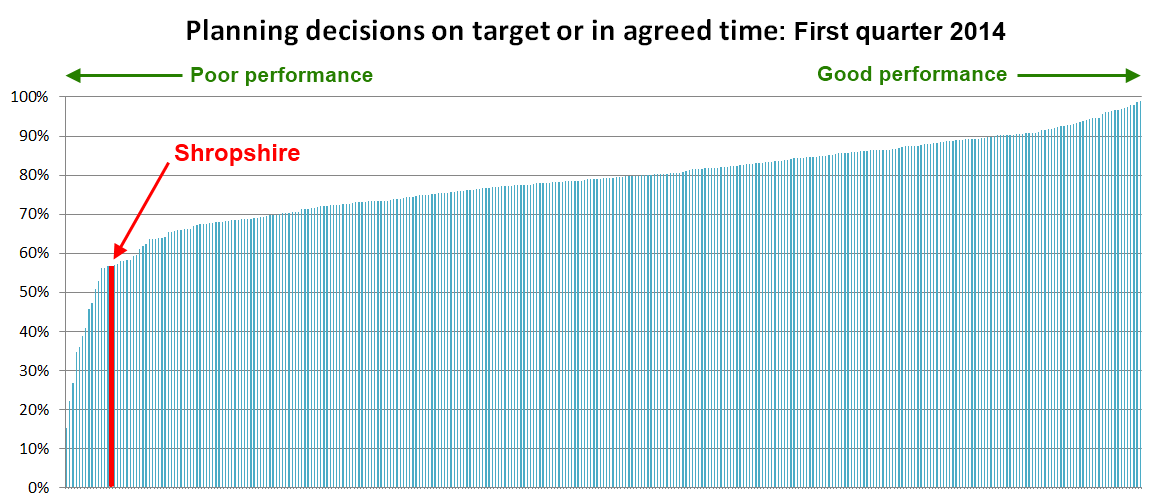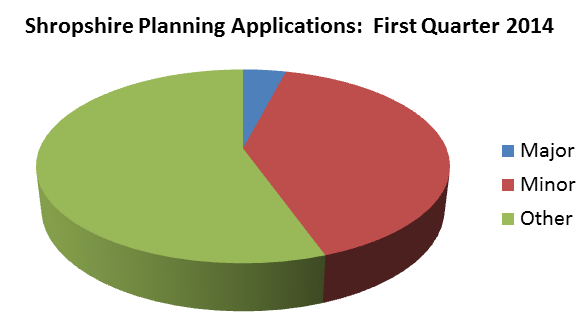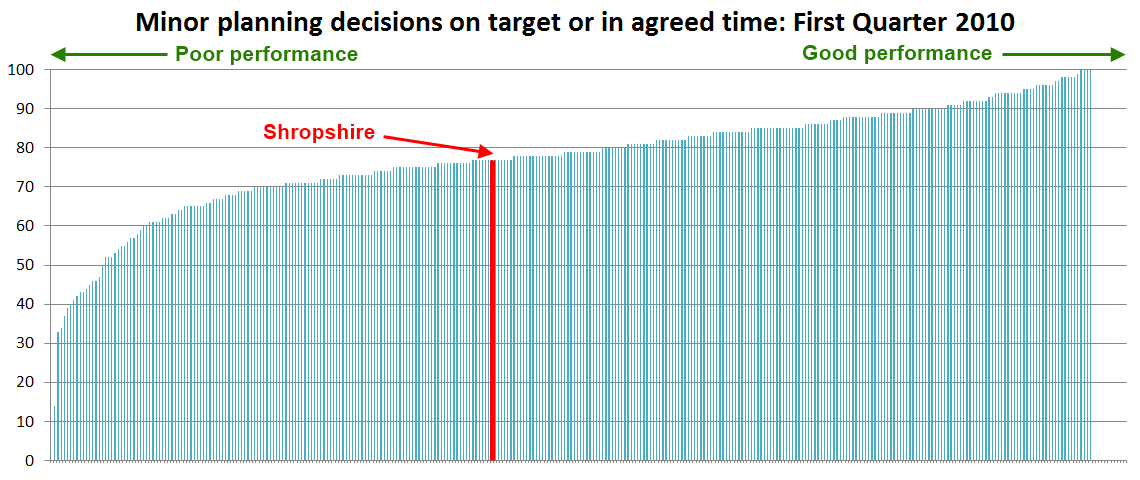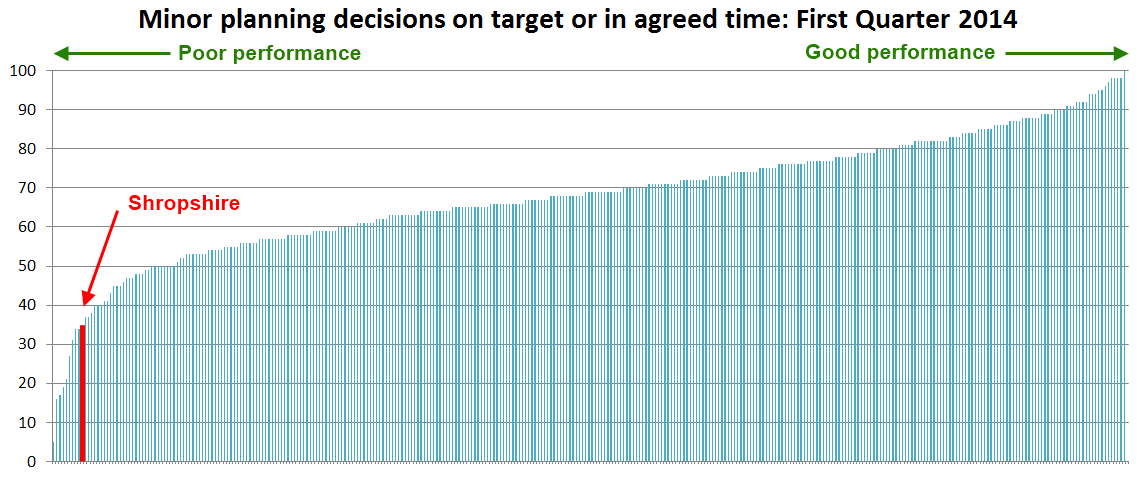It’s a truly shocking statistic. Only fourteen planning authorities in England have a worse planning performance than Shropshire (so we are 15th worst out of 338). That’s because the Shropshire Council has failed to invest in its planning operation. And it’s because the council is beholden by big developers and big businesses, not the small builders and entrepreneurs that make this county tick.
Back in 2010, we weren’t the best performer in planning but we were a long way from bumping along the bottom [1]. Now we are plummeting towards the abyss of planning failure and are amongst the worst planning authorities in the country.
In 2010, there were 94 planning authorities with a worse performance than Shropshire. In 2014, just 14 planning authorities have a worse performance than us.
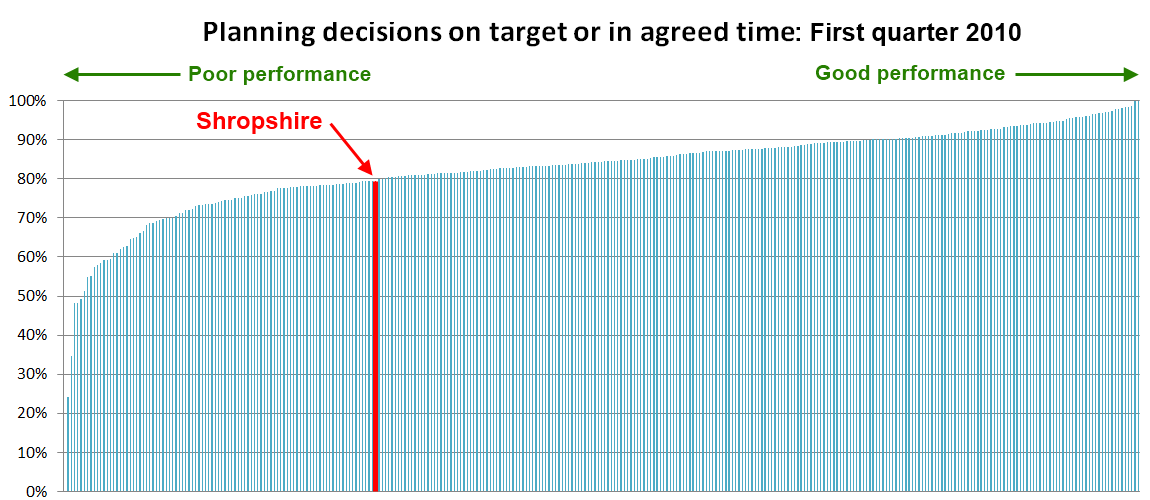 Each vertical bar is a planning authority [2]
Each vertical bar is a planning authority [2]
Shropshire does well on major applications, dealing with all of them within thirteen weeks or by a deadline agreed with the developer. This keeps it out of the government’s special measures scheme [3].
That’s all very fine but minor applications in this county outnumber major applications by ten to one and they are our major indicator of planning performance [4].
Back in 2010, 141 planning authorities had a worse performance than Shropshire in processing minor applications, so we were middling in performance [4]. In 2014, just 10 planning authorities performed worse than Shropshire in processing minor applications. So we are beginning to bump along the bottom. We have gone from being middle range to being at a point of failure in just four years. Small developers now have to wait several months to get a decision on developments that should be made within weeks.
Our performance on minor applications is frankly disgraceful. It means that we are discriminating against small developers who build the small plots of housing that we need in our villages and market towns. In Shropshire, particularly in the south of Shropshire, these small developers and local landowners are the lifeblood of our economy. By delaying giving planning consent, we are denying people the homes they need and the places they need to work. We are denying villages vitality. We are allowing market towns to stagnate. And we are denying the county the funding that new housing brings with it through the government’s New Homes Bonus, business rates, council tax and the community infrastructure levy.
Shropshire Council is currently in denial about its miserable planning performance. I have asked a question on this for tomorrow’s full Council meeting (25 September). In his response, the portfolio holder for planning, Mal Price, seems to be in complete denial about the collapse of planning performance in Shropshire. He says that missing targets that other planning authorities easily meet “is not an indication alone of poor performance.” I disagree. We are close to bottom of the class and our report card should be marked “must do better.”
Mal Price says that the council is “further refining business processes in order to increase capacity.” That’s close to meaningless. You can’t refine business processes unless you know how they tick. If you know how they tick, you know how much they cost. But Mal says:
“It is… difficult to put a precise figure on the cost of processing planning applications without undertaking a detailed time assessment.”
The council does know how much it spends on one of its most significant functions. I doubt there is another council in the country that doesn’t know how much it spends on planning.
Shropshire Council is failing on planning. It is failing itself by getting a reputation for being one of the worst performing planning authorities in the country. But above all, it is failing the people of Shropshire by not providing the people who live here the housing and places to work that they need.
Notes
[1] By planning performance, I mean the ability to decide whether to approve or reject planning applications in the target period or an otherwise agreed time. That target period is eight weeks for small (minor) applications; these are housing developments of 1-9 dwellings or under 0.5 hectares; or office, industrial or retail developments up to 999 sq m or under one hectare. The target for developments larger than this, known as major applications, is thirteen weeks. Extended timescales, known as planning performance agreements, are often negotiated for these bigger developments. By planning authorities I mean unitary, district or boroughs with local planning powers, and national parks.
[2] All applications (minor, major, other). Source: Department of Communities and Local Government Table P131.
[3] Under the special measures scheme, developers are able to bypass poorly performing planning authorities and take major applications directly to the planning inspectorate for a decision.
[4] There are also “other” applications. These are matters like change of use, advertising and listed building consents. The performance target is again eight weeks. In the first quarter of 2014, just 27 planning authorities performed worse than Shropshire in processing other applications.
[5] Eleven planning authorities did not submit planning performance data in Q1 2010.
Question to Council 25 September 2014 and the response
MR ANDY BODDINGTON will ask the following question:
Planning is one of the drivers of Shropshire’s future economy. Effective, efficient planning guarantees our county jobs and homes. Yet planning performance in the county is dropping.
It is welcome that major applications are currently processed in 13 weeks or an agreed time in line with government targets, keeping the county out of special measures. But performance on minor applications has collapsed.
These are housing developments of 1-9 dwellings or under 0.5 hectares; or office, industrial or retail developments up to 999sq m or under one hectare.
These developments are the lifeblood of our county like ours that is full of small businesses and house-builders, especially in the south of the county.
Minor applications outnumber major applications by ten to one and are the major indicator of planning performance in the county. In the first quarter of 2010, 77% of minor planning applications made in Shropshire were decided within the government target of eight weeks, the same as the average national performance. In the first quarter of 2014, just 37% of minor planning applications were processed in eight weeks, compared to a national performance of 68%.
My questions to the portfolio holder for built environment are:
1) What is the current average time taken to process a minor planning application in Shropshire?
2) Why has planning performance on minor applications collapsed?
3) What annual income does Shropshire Council receive from planning fees, including fees for pre-application advice?
4) How much does Shropshire Council spend annually on processing and deciding planning applications?
5) What plans are in place to improve performance on minor planning applications?
MR MALCOLM PRICE will reply:
I concur with Councillor Boddington’s view that Planning is one of the drivers of the economy and growth. In Shropshire 95% of planning applications are ultimately approved. The National NI157 performance indicators prescribed 8 week deadlines for the determination of planning applications with a target of 80% of such applications to be considered in this timeframe. Speed of decision taking is one measure of performance but taken in isolation it is not a qualitative measure.
In Shropshire, for the first quarter of this year 39% of minor planning applications were determined in 8 weeks and the average determination time for minor planning applications is closer to 16 weeks. There are a number of reasons for this and it is not an indication alone of poor performance. The Government has moved away from NI157 figures as a measure of planning performance and has retained this as a reporting measure for major planning applications. National Planning Performance reporting has aligned to the Shropshire approach of agreeing time frames for determination with the applicant and 96% of planning applications in Shropshire are determined in a timeframe agreed in this way.
Shropshire has a planning income target of £1.762M which includes fees for pre application advice. Planning fee income is very much linked to activity in the development economy and has generally fluctuated since Local Government Reorganisation in 2009 with an average of £1.71M. Last year there was a sharp increase in fee income (60%) most of the rise due to a significant increase in major housing and renewable energy planning applications which attract proportionately higher application fees than other schemes.
The cost to the Council of providing the regulatory planning service is spread amongst a number of cost centres and departments which contribute to delivery including various consultees to the process and legal and democratic services and overheads. It is therefore difficult to put a precise figure on the cost of processing planning applications without undertaking a detailed time assessment.
With regards to improving performance on minor planning applications, the Service is further refining business processes in order to increase capacity.
The option of increasing staffing during periods of increased demand on a flexible basis is also being explored. This approach would be monitored closely and adjusted if demand declines.

